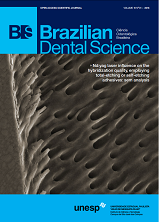Evaluation of bond strength of composite resin to enamel demineralized, exposed to remineralization and subjected to caries infiltration
DOI:
https://doi.org/10.14295/bds.2016.v19i1.1212Resumo
Objective: To evaluate the bond strength between resin composite and different enamel substrates: sound enamel; demineralized enamel submitted or not to remineralization; and demineralized enamel infiltrated with aninfiltrating resin. Material and Methods: 120 bovine teeth were selected, the root portion was removed and the enamel finished. Specimens were divided into the following groups: (A) Control (n=24): adhesively treated and restored; (B) (n=96): the samples were immersed in a demineralization solution to create white spot lesions and divided into four subgroups: (B1) demineralized enamel; (B2) samples were stored in artificial saliva (8 weeks); (B3) samples were stored in a 0.05% sodium fluoride solution (1 min day/8 weeks); (B4) samples were treated with an infiltrant resin (Icon, DMG). The groups were treated with one of the following adhesives: Clearfil S3 Bond Plus (Kuraray) or Single Bond Universal (3M ESPE), followed by the resin composite application (Filtek Z 350 XT, 3M ESPE). The specimens were submitted to thermalcycling aging (10,000 ×; 2±5ºC, 50±55ºC and 37°± 2°C). The specimens were sectioned into prism shapes with ~1mm² of base and submitted to microtensile test. The collected data were submitted to ANOVA and Tukey´s test (?= 5%). Results: The Means (±SD) in MPa were: Clearfill S3 Bond Plus: Control (17.17±3.52); B1 (11.60±0.74); B2 (6.83±1.87); B3 (8.38±1.59) and B4 (27.00±1.76); Single Bond Universal: Control (26.26±3.19); B1 (10.94±2.00); B2 (11.05±1.74); B3 (15.63±1.25) and B4 (22.60±2.29). Conclusion: The surface infiltrated with an infiltrating resin (Icon) did not negatively affect the bond strength between resin composite and enamel. The demineralized and remineralized groups with sodium fluoride and artificial saliva presented statistically lower results when compared to the other groups.
Downloads
Downloads
Arquivos adicionais
Publicado
Como Citar
Edição
Seção
Licença
TRANSFERÊNCIA DE DIREITOS AUTORAIS E DECLARAÇÃO DE RESPONSABILIDADE
Toda a propriedade de direitos autorais do artigo "____________________________________________________________________" é transferido do autor(es) para a CIÊNCIA ODONTOLÓGICA BRASILEIRA, no caso do trabalho ser publicado. O artigo não foi publicado em outro lugar e não foi submetido simultaneamente para publicação em outra revista.
Vimos por meio deste, atestar que trabalho é original e não apresenta dados manipulados, fraude ou plágio. Fizemos contribuição científica significativa para o estudo e estamos cientes dos dados apresentados e de acordo com a versão final do artigo. Assumimos total responsabilidade pelos aspectos éticos do estudo.
Este texto deve ser impresso e assinado por todos os autores. A versão digitalizada deverá ser apresentada como arquivo suplementar durante o processo de submissão.




























